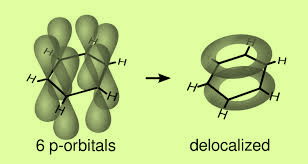
In benzene, what is the hybridization on each carbon atom?
A)${\text{s}}{{\text{p}}^2}$
B)${\text{s}}{{\text{p}}^3}$
C)${\text{s}}{{\text{p}}^3}{\text{d}}$
D)${\text{sp}}$
Answer
490.2k+ views
Hint: In benzene each carbon atom is joined to three other atoms-one hydrogen and two carbons. The carbon atom in benzene lacks the number of unpaired electrons to form bonds.
Complete step by step answer:
-The formula of benzene is ${{\text{C}}_6}{{\text{H}}_6}$.It is a six carbon ring with three alternate double bonds.
-At ground state the electronic configuration of carbon is $1{s^2}2{s^2}2p_x^12p_y^1$ -Since it lacks number of unpaired electron so it will promote one of the $2{s^2}$ electrons to jump into $2p_z^{}$ orbital.
-In excited state the electronic configuration of carbon will become- $1{s^2}2{s^1}2p_x^12p_y^12p_z^1$.So we get $4$ unpaired electrons and these electrons will participate in bond formation.
- The carbon atoms hybridize their outer orbital before forming the bonds as they have only three orbitals to hybridize. So they use $2{\text{s}}$ and two $2p$ orbitals to hybridize to form $3$ ${\text{s}}{{\text{p}}^2}$ hybrid orbitals and leave the other $2p{\text{ }}$ electrons unchanged.
- The three ${\text{s}}{{\text{p}}^2}$ hybrid orbitals arrange themselves at ${120^ \circ }$ to each other in the plane. Out of the three hybrid orbitals two orbitals overlap axially with orbitals of the neighboring carbon atoms on the both sides to form sigma bonds.

The left p orbital overlap sidewise with similar orbitals of the other carbon atoms on either side to form two sets of pi-bonds. So the resultant pi-cloud is formed over all the six carbon atoms. This is known as the delocalization of electron charge. Benzene has trigonal planar geometry.
So the correct answer is A.
Note:
Benzene has following applications-
1.It is used to make plastics, resins, synthetic fibers.
2. It is used to prepare detergents, dyes, drugs and pesticides.
Complete step by step answer:
-The formula of benzene is ${{\text{C}}_6}{{\text{H}}_6}$.It is a six carbon ring with three alternate double bonds.
-At ground state the electronic configuration of carbon is $1{s^2}2{s^2}2p_x^12p_y^1$ -Since it lacks number of unpaired electron so it will promote one of the $2{s^2}$ electrons to jump into $2p_z^{}$ orbital.
-In excited state the electronic configuration of carbon will become- $1{s^2}2{s^1}2p_x^12p_y^12p_z^1$.So we get $4$ unpaired electrons and these electrons will participate in bond formation.
- The carbon atoms hybridize their outer orbital before forming the bonds as they have only three orbitals to hybridize. So they use $2{\text{s}}$ and two $2p$ orbitals to hybridize to form $3$ ${\text{s}}{{\text{p}}^2}$ hybrid orbitals and leave the other $2p{\text{ }}$ electrons unchanged.
- The three ${\text{s}}{{\text{p}}^2}$ hybrid orbitals arrange themselves at ${120^ \circ }$ to each other in the plane. Out of the three hybrid orbitals two orbitals overlap axially with orbitals of the neighboring carbon atoms on the both sides to form sigma bonds.

The left p orbital overlap sidewise with similar orbitals of the other carbon atoms on either side to form two sets of pi-bonds. So the resultant pi-cloud is formed over all the six carbon atoms. This is known as the delocalization of electron charge. Benzene has trigonal planar geometry.
So the correct answer is A.
Note:
Benzene has following applications-
1.It is used to make plastics, resins, synthetic fibers.
2. It is used to prepare detergents, dyes, drugs and pesticides.
Recently Updated Pages
The correct geometry and hybridization for XeF4 are class 11 chemistry CBSE

Water softening by Clarks process uses ACalcium bicarbonate class 11 chemistry CBSE

With reference to graphite and diamond which of the class 11 chemistry CBSE

A certain household has consumed 250 units of energy class 11 physics CBSE

The lightest metal known is A beryllium B lithium C class 11 chemistry CBSE

What is the formula mass of the iodine molecule class 11 chemistry CBSE

Trending doubts
Why was the Vernacular Press Act passed by British class 11 social science CBSE

Arrange Water ethanol and phenol in increasing order class 11 chemistry CBSE

Name the nuclear plant located in Uttar Pradesh class 11 social science CBSE

One Metric ton is equal to kg A 10000 B 1000 C 100 class 11 physics CBSE

What steps did the French revolutionaries take to create class 11 social science CBSE

How did silk routes link the world Explain with three class 11 social science CBSE




